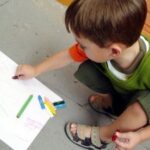The food chain of the animal kingdom is an important lesson that all elementary level students should learn about. Below is a two day lesson plan involving the food chain. The first day outlines for the students exactly what the food chain is, even naming typical animals that work together to form the chain. It will invoke thought in the students, causing them to think about which animals might be where in the food chain. This makes the lesson much more effective in staying in the children’s minds. The second day involves an art lesson that collaborates with it.
Day One
For this lesson, read the below italicized paragraphs to the students.
The animal kingdom is made up of many different animals. In a way they all need to work together in order to survive. Each animal needs another animal or plant for survival. It starts from the smallest of animals and continues on, all the way up to the largest.
This togetherness is called the food chain. The smallest animals in the chain will be the ones that do not eat other animals, but eat plants and fruits , vegetables, and seeds that come from plants instead. These are called herbivores. The rest of the animals in the chain are called either carnivores or omnivores. Carnivores eat only meat, which, of course, is other animals. Omnivores eat from both food groups, so that means they eat what both carnivores and herbivores eat. Humans are omnivores.
A typical food chain starts from a small animal, such as a mouse or squirrel. That animal eats only things that grow. The next animal can be either an omnivore or carnivore. A snake is a carnivore. That snake will eat the herbivore, continuing the chain. Next, a hawk, who is a carnivore, could swoop down and eat that snake, making the chain continue. Then, if a fox, who is also a carnivore, eats that hawk, the chain has kept going. A clouded leopard could then eat the fox, which, again, continues the cycle. As you can see, the cycle will keep going. This is what makes it a food chain.
Once the above scenario has been read to the children, draw a diagram on an overhead or chalkboard to show the students what a food chain is. Instead of listing the actual animals, each circle should stay blank. The circles should connect in order. Next, show the children on the diagram how each animal needs the other, which creates a chain, by creating a chain of your own. Then, erase your animals from the circles. Ask them to suggest animals for each section of the food chain and discuss why or why not certain animals belong in certain parts of the chain you create together. Repeat making the chain a few times. Ask the children to think about the food chain once school is over and discuss it with a friend or family member. If you homeschool, ask the child to discuss the food chain with a friend or a family member who is not schooling with him or her.
Day Two
For the second day of instruction, students will need to create a food chain of their own. Each student will need one 12×7 sheet of construction paper, a glue stick, a pencil, and crayons or washable markers. They should use all of these materials, with the sheet of paper as a base. Students should label the animals as “herbivore”, “carnivore”, or “omnivore”, with numbers and arrows symbolizing which ones come next. This art should be a combination of drawing, writing, and pictures cut and glued from magazines. Let the students create the scene as they please, so long as everything is labeled correctly.
This activity is not only fun for the children, but it further ensures that the lesson will stay in their brain and it also gives them a hands-on association to base the lesson from.
Once both days are completed, students should have a very good understanding of the concept of a food chain and how it works.
To read more from this author, please click on her picture above.




